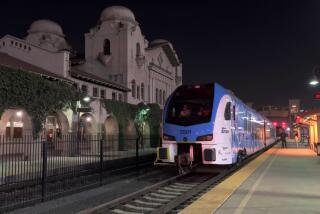‘Stealth’ Bus : RTD Wins Grant to Help Develop Transit Uses for High-Tech Materials
Efforts to develop an advanced transportation industry in Southern California were boosted Tuesday when federal officials awarded the Southern California Rapid Transit District a $3.2-million grant to develop a revolutionary lightweight, low-floor, clean-air bus.
The program--waggishly nicknamed the “Stealth bus” project--will explore the feasibility of using super-strong composite materials and other modern aerospace technologies to build safer, cleaner, fuel-efficient buses that can stand up to stop-and-go driving and vandals.
“Up until now, talk of converting defense industry technology has been hot air and press releases,” said RTD board President Marvin Holen. “Not any more.” He promised “a new bus for the 21st Century” that will use materials “like those used in the Stealth bomber.”
The RTD, which screened potential partners before the project was funded, has selected four aerospace titans--Northrop Corp., TRW, Hughes Aircraft and Lockheed--to compete for the right to work with the district on the project, which is funded by the Federal Transit Administration.
The FTA-RTD program was announced less than three weeks after Hughes and Lockheed said they had teamed up with rail car builder Morrison Knudsen Corp. to develop a high-tech train for the Los Angeles County Transportation Commission’s Advanced Transit Project Development Program.
The bus program will be developed in three phases, from design to mock-up to prototype. Total cost of the project is $27.2 million, with 80% paid by the federal government and the rest by the RTD’s share of the county’s one-cent transit-related sales tax surcharge.
Only the first, $4-million phase was funded Tuesday. Funding for later phases will depend on whether the process appears practical, said John Ek, the RTD’s Washington representative. The RTD plans to produce five or six working prototypes for testing around the country.
The FTA is trying to get another $25 million for the project from a new Pentagon program aimed at helping defense contractors convert to civilian production. The money would enable the RTD to build 15 additional prototypes for expanded testing, Ek said.
In addition to developing buses that are lighter and stronger, engineers will try to design buses with floors closer to the ground. By eliminating steps, the design would allow faster passenger boarding and easier access for children, the elderly and people in wheelchairs.
More to Read
Inside the business of entertainment
The Wide Shot brings you news, analysis and insights on everything from streaming wars to production — and what it all means for the future.
You may occasionally receive promotional content from the Los Angeles Times.










